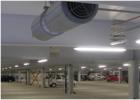Ventilation of Enclosed Car Parks Using Jet Thrust System
Ventilation of Enclosed Car Parks Using Jet Thrust System
Flakt Woods offer complete car park ventilation systems, including high specification fully reversible Main Extract Fans and Jet Thrust Fans. Flakt Woods is the only manufacturer in the World to offer products with Truly Symmetrical technology, achieving 100% thrust in both forward and reverse operation. In the event of a fire, this new technology allows smoke to be directed to the nearest extract point, making Flakt Woods Jet Thrust System among the safest on the market today.
Car park system design is backed up by a team of committed and highly trained engineers – specialists in car park ventilation, using the latest full fire-modelling CFX software, with complete CFD (Computational Fluid Dynamics) ventilation modelling applied to each individual project, ensuring accuracy, operational and cost effectiveness in design.
Flakt Woods invests considerable time and resources to maintain their position as world leaders in fan technology. Constant product improvements, research and design, are at the very core of Flakt Woods engineering ethos and application knowledge expertise.
INTRODUCTION TO CARK PARK VENTILATION
Over the past decade, car park ventilation using jet thrustfans has been replacing the more traditional method of ducted extract over the past decade in providing more efficient and cost effective ventilation of enclosed and underground car parks.
DUCTED SYSTEMS IN BUILDINGS
Traditionally, the ventilation of a large enclosed space within a building (as opposed to car parks) has been achieved by supplying the treated air at a high level, into the space via a system of distribution ductwork, terminating at a number of small grilles or diffusers. The airflow out from these diffusers induces additional air movement, above and beyond the air discharging from the grille itself, by entraining the air around the discharge. This movement should ensure an even distribution, throughout the space, by mixing the ‘new’ air with the ‘old’, (although it will be demonstrated later in this text that this is often not the case). The air is then extracted or recirculated accordingly.
DUCTED SYSTEMS IN CAR PARKS
For over the past 20 years car park ventilation systems have used a system of extraction through ductwork connected to exhaust fans sized to provide an air change rate within the car park. Incoming air is allowed to enter freely, normally via vehicle ramps, with the air extracted from a fixed points via the ductwork. This means there is no control over the amount of incoming air entering the car park. In the majority of cases, this can seriously affect the efficiency of the system.
JET THRUST SYSTEMS
Jet Thrust Systems, or generically ‘Impulse Ventilation’, uses a number of strategically placed Jet Thrust Fans suspended from the car park ceiling replacing the ductwork (see Fig 1.3.1). The system has Main Extract Fans to provide the required air change rate, whilst the Jet Thrust Fans themselves create and control the air movement within the space. Jet Thrust Fans have a similar function as the diffusers in a traditional ducted system, allowing control over the supply air movement within the car park.
VENTILATION OF ENCLOSED CAR PARKS
VENTILATION REQUIREMENTS
The ventilation system for an enclosed car park has two functions:
- To remove vehicle exhaust fumes, mainly carbon monoxide, during normal car park usage creating and acceptably conditioned environment.
- To remove the smoke in the event of a fire to assist in providing a safe means of escape.
In the UK the design specifications covering these two functions are set out in detail in Approved Documents B and F of the Building Regulations of England and Wales, and similar recommendations are contained in the technical documents for Scotland. Many other countries either adopt these standards or have separate standards or regulations of their own.
For the UK, the standards currently are:
- 6 ac/hr, (or a ventilation to maintain the CO level < 50ppm for fume control function).
- 10 ac/hr, or a ventilation rate based on the requirements in BRE 368[1], for fire smoke removal.
- The total ventilation duty to be divided between two fans
- These fans to be capable of surviving a minimum of 300oC for 1 hour
- The exhaust ductwork system to have extract grilles, 50% at high level and 50% at low level
- Consideration is to be given to the supply of replacement air.
DAY-TO-DAY FUME EXTRACT
To compare the differences in performance between a ducted and a Jet Thrust System, we can take a typical example:
A rectangular shaped car park, 4000m2 in area and 3m high, is ventilated by a ducted extract system designed to the requirements of Approved Documents B and F. The required ventilation duty of 20m3/sec giving 6 air changes/hour, and is divided between two Main Extract Fans, with 100 extract grilles (50 at high level and 50 at low level) placed evenly throughout the car park. Replacement air is via a vehicle entrance / exit ramp in the top left hand corner of the car park.
The same car park is then ventilated, without ductwork, using a Jet Thrust Fan system comprising of 16 355 mm Jet Thrust Fans.
Both these systems were modelled using Computational Fluid Dynamic (CFD) software, and the respective performances predicted and compared.

